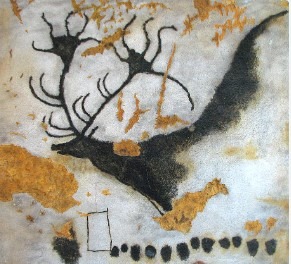Note: Unlike the HTML text below, the PDF version will allow you to :
- visualize proto-Sumerian ideograms
- better visualize the numbering of Sumerian homophones transliterated from cuneiform (their numbering index is placed at the bottom right and in a small format)
- visualize hieroglyphs and not just their transliterations
Table of contents
Preliminary note
For the time being, this analysis is limited to the etymological analysis, and has yet to include the various examples drawn from the comparative mythological analysis of the civilizational mythological variations of the two symbols studied.
Note also that this analysis is repeated in Volume 2, Book 1, “Deciphering the language of the caves”, auroch and bison being major figures in cave sacred art.
Etymological analysis (Sumerian, Egyptian hieroglyphic and demotic)
In Sumerian
In Sumerian, there are two words for deer: lulim[1] and a-ia10-lum[2].
Let’s take a look at Lulim which is currently sufficient.
Lulim can be broken down into lu-lim[3].
Lu
As I have already mentioned (cf. auroch analysis alim), lu in Sumerian means a man, humans or a herd[4] ; lú designates an adult male[5] ; lú-u18 designates a human being and humanity in general[6].
We also noted that this logogram is an example of the recurrent association of man with the animal by lu or lú-u-um18 [7].
We have also seen that lugal [8], literally “the great man”, meaning “a king, a master”.[9]
Lim
We’ve already seen the meaning of this lim logogram in our examination of the auroch, the bison and the wild bull. alim.
We have seen that lim means :
- li-im or lu-im expresses the idea of a grown man with a body made of clay and mud, who can be associated with an animal, whose body radiates splendor like a divinity and who is a father.
- lim as equivalent to lum refers to a complete, healthy, fertile male, but also to fertilizer, manure for luxuriant growth, to a reproductive sire.
- lim by its equivalence with lam, designates a divine being endowed with abundant power, source of abundance and ruler of the underworld.
Conclusion on the Sumerian meaning of lulim
These double meanings put together allow us to grasp the imagery of the stag symbol, which obviously goes far beyond the simple animal (hunted), but is a mythological figure, an avatar of primordial man drawn from clay, a complete, healthy man, who at his death became dung and was deified as father of the gods reigning over the underworld and source of abundance on earth.
This deer, lulim serves to conceal its identity as a « lu “a man, a human. The primordial human, like alim, auroch is used to mask « a “the primordial “father”.
On the fact that lu is used to represent the deer, I find it interesting to note what the dictionary of symbols says about it, namely that in China “ohere’s also mention of a symbol of longevity, but above all of prosperity, based on the usual popular puns, because lou means at the same time deer and emoluments[10]. (CHEVALIER-GHEEBRANT, Dictionnaire des Symboles, 2005, p. 197).
The fact that deer is pronounced lou in Chinese (and also means emoluments whereas, as we shall see, the notion of “wages” is attached to the father) which, as we have seen, is a language that in certain respects has obviously been impregnated by archaic Sumerian thought, is quite symptomatic.
In hieroglyphic Egyptian
In confirmation of the fact that the deer in fact represents a man, in this case primordial man, it’s also very interesting to turn to Sumerian’s consanguineous semiological system, that of hieroglyphics.
Indeed, in book 2 of volume 2 entitled “From God to Adam” it is demonstrated, by many concordant etymological axes, that the Sumerian couple lu or lú / lú-u18 has the same equivalence of meaning as the Egyptian pair Hn / Hnmmt.
We can simply say here, for the moment, that Egyptian hieroglyphic Hnmmt [11] means “humanity”.
This alone allows us to deduce that its root logogram Hn means the human (first and foremost, the first human, the primordial father).
In fact, the particle mmt gives the preceding logogram the character of a noun.
For example: nDm is something soft, pleasant[12] and nDmmt is sexual pleasure[13] ; Sm means having a fever[14] et Smmt refers to fever[15].
Hn means then human.
And, as I’ll also have the opportunity to demonstrate, Hn and hn are equivalent logograms in Egyptian.
How do you say deer in hieroglyphic Egyptian?
hnn [16]…
In Demotic :
If we turn to Demotic, we see the same association, albeit indirect, between lu and the father.
Indeed, the demotic lala which means to weep, to lament (ang. to wail)…[17] :
is associated with llul meaning a cry (shout) [18]
Now, in Sumerian, cri is synonymous with father through “ad(a)[19]” and el/al or la are used interchangeably to mean “raised father”, a contraction of « a » or « e4 »[20] and « íla, íli, íl » « to be raised »[21].
Volume 2 shows why cries and lamentations have been associated with the primordial father, but this simple semantic equivalence between the demotic la / lul with the Sumerian a / al / la / lu rsending to the deified father is very telling.
Conclusion of etymological analysis (Sumerian, Egyptian hieroglyphic and demotic)
This brief etymological analysis of the Sumerian word for deer lu of the Egyptian hieroglyphic hnn and demotic lala/llul has enabled us to understand that the deer is indeed an avatar of primordial man.
Describing him as a complete, healthy man, taken from clay, who at his death became dung and was deified as the father of the gods reigning over the underworld and regarded as the source of abundance on earth.
Footnotes :
[1] lulim : stag, hart (male of the red deer; cf., máš-lulim) (Akkadian loanword) (A.Halloran, 1999, p. 62) ; Volume 4 / Sumerian-French lexicon : lulim = deer (male member of the red deer family; see máš-lulim) (akkadian loanword).
[2] a-ia10-lum : stag (Akkadian loanword) (A.Halloran, 1999, p. 72) ; Volume 4 / SLexique sumérien-français a-ia10-lum :: cerf (emprunt Akkadien)
[3] Note that in the Halloran lexicon we are also told that lulim is a contraction of “to graze” (lu) and “thousands (lim) : lu-lim : stag (Akkadian loanword ?; ‘to graze, pasture’ + ‘thousand’) (A.Halloran, 1999, p. 115) ; Volume 4 / Sumerian-French lexicon : lu-lim : deer (Akkadian loanword ?; “to graze” + “thousands”).
That may be its literal meaning, but lu and lim don’t just have these senses…
[4] lu : n., many, much; man, men, people; sheep. v., to be/make numerous, abundant; to multiply; to mix; to graze, pasture (reduplication class [?]) (cf., lug) (A.Halloran, 1999, p. 12) ; Volume 4 / Lexique sumérien-français : lu = beaucoup ; homme, humains, gens, peuple ; troupeau. Verbs: to make numerous, abundant; to multiply; to mix; to graze.
[5] lú : grown man; male; human being; someone, anyone, no one; gentleman (A.Halloran, 1999, p. 12) Volume 4 / Lexique sumérien-français : lú = homme adulte ; mâle ; être humain ; quelqu’un, n’importe qui, personne ; gentleman.
[6] lú-u18[ÑIŠGAL]– (lu) : mankind; human being (‘humans’ + ‘huge’ [ + ‘numerous’]) (A.Halloran, 1999, p. 117) ; Cf Volume 4 / Lexique sumérien français : lú-u18[ÑIŠGAL]-(lu) = humanité ; être humain (humains + énorme + nombreux)
[7] lú-u-um18 : name of a breed of small cattle (possible Semitic loanword) (A.Halloran, 1999, p. 117) ; Cf Volume 4 / Lexique sumérien français : lú-u-um18 : nom d’une race de petit bétail (possible emprunt sémitique).
[8] (CNIL, 1996?, p. 128)
[9] lugal : king; owner, master (lú, ‘man’, + gal, ‘big’) (A.Halloran, 1999, p. 62) ; Volume 4 / Lexique sumérien-français : lugal : roi ; propriétaire, maître (lú, homme + gal, grand)
[10] The books in volume 2 show that, just like the notion of share, portion, the notion of wages (emoluments) is attached to the father.
[11] Cf Volume 4 / Hieroglyphic-French lexicon : Hnmmt solar people of Heliopolis; humanity (Faulkner, repr. 2017, p. 213)
[12] Cf Volume 4 / Hieroglyphic-French lexicon : nDm soft, sweet; pleasant; wholesome; at ease (Faulkner, reed.2017, p. 179)
[13] Cf Volume 4 / Hieroglyphic-French lexicon : nDmmyt nDmmt sexual pleasure, passion (carnal)
[14] Cf Volume 4 / Hieroglyphic-French lexicon : Smm to be hot, burning; to have fever, to become feverish; also Sm (Faulkner, réed.2017, p. 326)
[15] Cf Volume 4 / Hieroglyphic-French lexicon : Smmt fever; inflammation (Faulkner, reed.2017, p. 326)
[16] Cf Volume 4 / Hieroglyphic-French lexicon : hnn deer, fallow deer pay attention to, take into consideration; trust; give assent to; approve; coax ; antonym of HDn to be reluctant, to disapprove (Neo-Egyptian) (Faulkner, reed.2017, p. 196)
[17]https://oi.uchicago.edu/research/publications/demotic-dictionary-oriental-institute-university-chicago / L, p.3
[18]https://oi.uchicago.edu/research/publications/demotic-dictionary-oriental-institute-university-chicago / L, p.12
[19] ada, ad : n., father; shout; song. v., to balk. (A.Halloran, 1999, p. 18) ; Volume 4 / Lexique sumérien-français = ada, ad = nominatif : père, cri, chant / verbe : rechigner
[20] a, e4 = noun. : water; watercourse, canal; seminal fluid; offspring; father; tears; flood (A.Halloran, 1999, p. 3) avec traduction au Volume 4 / Lexique sumérien-français : a, e4 = au nominatif = eau, cours d’eau, canal, fluide séminal, descendance, père, larmes, inondation ou déluge.
[21] íl-lá: elevation (‘to lift’ + ‘to hang’; cf., dùn-lá, ‘depression’) (A.Halloran, 1999, p. 105) ; Volume 4 Lexique sumérien-français : íl-lá = élévation (« lever » + « suspendre »).
íla, íli, íl: n., carrier.., to lift, carry; to deliver; to bring; to endure; to support; to carry forward (in accounting); to be high; to shine (íl-i in marû) (A.Halloran, 1999, p. 105) ; Volume 4 Sumerian-French lexicon : íla, íli, íl = nominative: carrier; verb: to lift, to carry, to deliver, to bring, to endure, to bear, to postpone; to be elevated; to shine (íl-i à marû)
Copyright reminder
As a reminder, please respect copyright, as these materials have been registered.
©YVAR BREGEANT, Avril 2023 All rights reserved
The French Intellectual Property Code prohibits copies or reproductions for collective use.
Any representation or reproduction in whole or in part by any process whatsoever without the consent of the author or his successors is unlawful and constitutes an infringement punishable by articles L335-2 et seq. of the French Intellectual Property Code.

